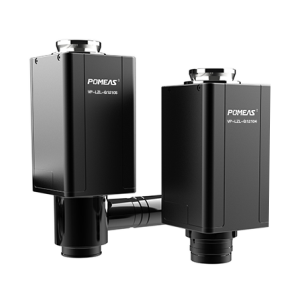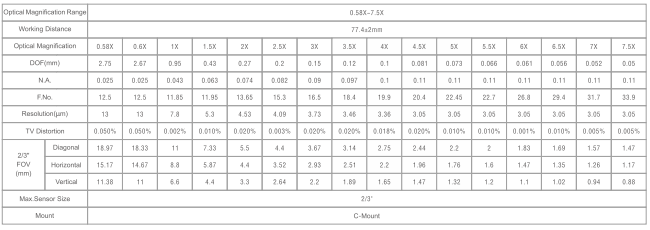
Compared to traditional zoom lenses, guideway zoom lenses adopt a rail motion structure. This design greatly reduces the friction coefficient of group movement, thus significantly improving the service life of the lens as well as the stability of the optical performance. When selecting a rail-mounted zoom lens, it is crucial to understand its key parameters. The following are the main parameters of a rail-mounted zoom lens and their significance:


1. Zoom range: The zoom range refers to the range of magnification that the lens can realize. The wider the magnification range, the lens is suitable for more detection scenes, to better meet the needs of different applications.
2. working distance: working distance is the distance from the front of the lens to the surface of the object to be measured. For the rail zoom lens, the working distance is fixed or adjustable, depending on the design of the lens.
3. Optical magnification: Optical magnification refers to the proportion of the lens to the actual size of the object to be measured magnification. Optical magnification directly affects the magnification effect of imaging, is one of the important factors to consider when choosing a lens.
4. Depth of field: depth of field refers to the premise of maintaining a clear image, the lens is able to clearly image the object before and after the distance range, the greater the depth of field, indicating that the lens is able to clearly image a wider range of objects, which is particularly important in some applications that require a wide range of clear imaging.
5. N.A.: N.A. is a parameter that describes the ability of the lens to collect light, which is closely related to the lens's ability to pass light and resolution. the larger the N.A., the stronger the ability of the lens to collect light, the higher the resolution and contrast of the image. 6.
6. F.No.: F.No. is an important parameter of the lens luminous flux, usually expressed in terms of the number of F. The smaller the number of F, the greater the luminous flux of the lens, in the light of the environment, the choice of a smaller number of F can improve the luminous flux of the lens, thereby improving the quality of imaging.
7. Resolution: refers to the smallest object size or detail that the lens can distinguish, the higher the resolution, that the lens can capture the details of the richer, the better the image quality.
8. TV Aberration: TV Aberration is the image distortion phenomenon produced by the lens in the imaging process. It is usually expressed as a percentage, the smaller the value means the smaller the distortion.
Parameter list of guide zoom lenses:

Product recommendation
TECHNICAL SOLUTION
MORE+You may also be interested in the following information
FREE CONSULTING SERVICE
Let’s help you to find the right solution for your project!

- APPICATION CASE
- RESOURCE CENTER
- DOWNLOAD CENTER
SOLUTIONS SUPPORT
- ZOOM LENS SELECTION TOOL
- TELECENTRIC LENS SELECTION TOOL
- FA LENS SELECTION TOOL
- ZOOM RATIO TABLE
- CERTIFIED MODEL
SELECTION TOOL
- WHY POMEAS
- FAQ
- PRIVACY POLICY
- TERMS OF USE
- DELIVERY & RETURN POLICY
CUSTOMER CARE
 ADDRESS
ADDRESS
Add.:No.68, Chongwei Road, Baizhoubian, East district, Dongguan, China, 523000
CONTACT
 Tel:+ 86-0769-2266 0867
Tel:+ 86-0769-2266 0867
 Fax:+ 86-0769-2266 0867
Fax:+ 86-0769-2266 0867
 E-mail:marketing@pomeas.com
E-mail:marketing@pomeas.com

Wechat QR code

 ASK POMEAS
ASK POMEAS  PRICE INQUIRY
PRICE INQUIRY  REQUEST DEMO/TEST
REQUEST DEMO/TEST  FREE TRIAL UNIT
FREE TRIAL UNIT  ACCURATE SELECTION
ACCURATE SELECTION 